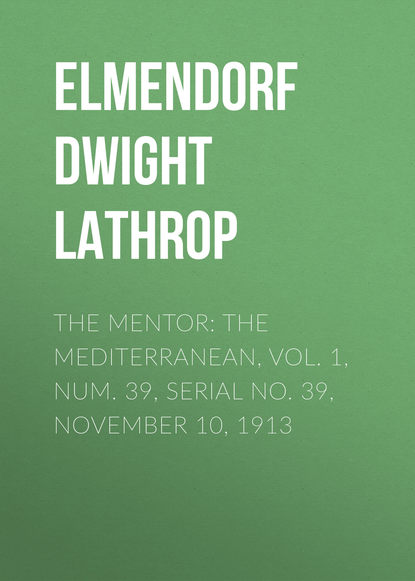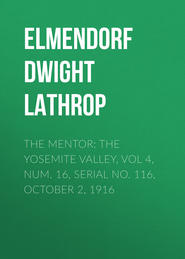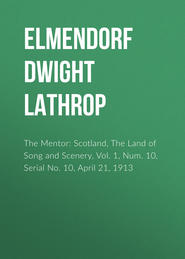По всем вопросам обращайтесь на: info@litportal.ru
(©) 2003-2024.
✖
The Mentor: The Mediterranean, Vol. 1, Num. 39, Serial No. 39, November 10, 1913
Настройки чтения
Размер шрифта
Высота строк
Поля
Nice is a great commercial town. Grapes, olives, oranges, and mulberries are grown profusely, and in the city there are perfumery factories, oilworks, furniture factories, confectionery works, a national tobacco factory, and many others.
For the comfort and entertainment of visitors every provision is made. Autumn is the best season. Nice is at its liveliest during the carnival festivities. In these carnivals battles are waged with sweetmeats and flowers.
GENOA, ITALY
“Seas without fish, mountains without trees, men without honesty, women without modesty,” – that was what her enemies said about the republic of Genoa in olden times. And historians seem to agree that the character of the Genoese in those days was not of the best. All their energy was concentrated on commerce and the pursuit of money. They took no interest in art nor in any of the intellectual development of Italy during the Middle Ages. But these bad traits of the Genoese have all disappeared.
The city of Genoa now has 275,000 inhabitants, and is the seat of a university and an archbishop. It is the headquarters of the fourth Italian army corps, and is a strong fortress, as well as being the chief commercial town in Italy.
Genoa, with its many beautiful palaces, rising above the sea in a wide half-circle, is called “La Superba” (the superb). The old town is a network of narrow and steep streets, lined with many-storied buildings; but the newer part of the city has broad and straight thoroughfares.
In the seventeenth century the Genoese built as a protection against their enemies a rampart over nine miles long. They also erected on the heights around the town ten detached forts.
From the earliest times Genoa has been famous as a seaport. Today it still possesses its great mercantile supremacy, and in addition is an important emigration harbor. Far back in 400 B. C. its trade with the Greeks, Etruscans, and Celts was large, and as time went on it increased greatly.
In the Middle Ages the little rival Italian states were constantly at war with one another. Genoa had a war with Pisa, and in 1284 shattered the power of that city forever in a terrible naval battle at Meloria. Then came the struggle with Venice which ended in the defeat of Genoa at the battle of Chioggia in 1380.
The city of Genoa was also filled with internal political strife. Two or three different factions were continually fighting with one another, and this finally led to Genoa’s being always under the rule of some foreign prince. Finally in 1797 the aristocratic government of Genoa was superseded by the democratic Ligurian Republic, established by Napoleon, and in 1805 Liguria was formally annexed to the empire of France. Ten years later it was annexed to the kingdom of Sardinia.
Giuseppe Mazzini, the patriotic writer, was born at Genoa in 1805, and Garibaldi, the great Italian patriot and leader, with whom he worked, though born at Nice in 1807, was the son of a Genoese of Chiavari.
NAPLES, ITALY
Naples, the most important seaport in Italy, is also its largest city. In addition to this it is one of the most beautifully situated cities in the world.
The ancient Greeks founded Naples away back in olden times. They came from Cumæ and founded a city which they named Parthenope. Afterward this was divided into Palacopolis, the “old town,” and Neapolis, the “new town.” It was from the second that Naples got its name.
Later many other nations came into possession of the city, – Ostrogoths, Byzantines, and Normans. At one time Charles of Anjou made Naples his capital. Ferdinand I of Aragon, the Spanish viceroy, Don Pedro de Toledo, and the Bourbon Charles III all extended the city. Finally in 1860 the kingdom of which Naples was the capital was united to the kingdom of Italy.
Naples has not so many historic and artistic monuments as other Italian cities; but in the museum are preserved valuable treasures from Pompeii and Herculaneum, the old Roman cities that were destroyed by Vesuvius, and only within recent years have been excavated.
The best view of Naples may be had from the Bay of Naples. The city is built at the base and on the slopes of a range of volcanic hills, and rises from the sea like an amphitheater. The Castle of St. Elmo occupies a hill, from which a transverse ridge runs south to form the promontory of Pizzofalcone and divides the city into two natural crescents. The western part, the Chiara ward, is a long, narrow strip between the sea and Vomero Hill. This is the fashionable quarter. To the east lie the oldest and busiest quarters, of which the long Via Roma is the main street.
One cannot speak about Naples without mentioning Vesuvius. As one writer said, “Mount Vesuvius is to the Neapolitan bay what Fujiyama is to many a landscape of Japan, – the lofty background of the picture, and the grand presiding genius of the place. By day it proudly waves its plume of smoke, by night its torch of fire, as if it claimed to be the champion of destruction.”
A cable railway ascends Vesuvius now, and for many years the mountain has been quiet. But it is only slumbering. Some day it will break loose again and pour forth its streams of redhot lava, its agents of destruction.











